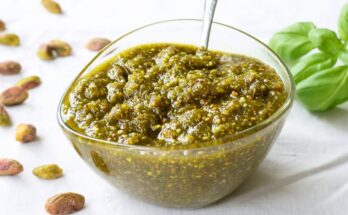Donut Recipe: Donuts are a beloved treat worldwide, offering a delightful combination of soft, fluffy dough and sweet, decadent toppings.
While store-bought donuts can be convenient, there’s something magical about creating your own donuts from scratch.
Not only do homemade donuts taste fresher, but they also allow you to customize flavors and experiment with endless possibilities.
Ready to dive into the world of donut-making? Let’s get started with this easy-to-follow guide.
Ingredients for Homemade Donuts
To make the perfect donuts, you’ll need a mix of basic pantry staples and a few extras for flavor and decoration. Here’s what you’ll need:
Dry Ingredients:
- 3 ½ cups of all-purpose flour
- ¼ cup of sugar
- 1 teaspoon of salt
- 1 packet (2 ¼ teaspoons) of active dry yeast
Wet Ingredients:
- 1 cup of warm milk (around 110°F)
- 2 large eggs
- ¼ cup of unsalted butter, melted
- 1 teaspoon of vanilla extract
Additional Toppings:
- Powdered sugar or cinnamon sugar for dusting
- Chocolate, vanilla, or strawberry glaze
- Sprinkles, nuts, or shredded coconut for garnish
These ingredients yield about 12 donuts, but you can adjust quantities for larger or smaller batches.
Types of Donuts
Donuts come in various forms, and understanding the difference can help you choose the right recipe for your taste.
Yeast Donuts:
These are light and airy, thanks to yeast fermentation. They require proofing but are worth the extra time.
Cake Donuts:
Made with baking powder or soda, these donuts are denser and have a crumbly texture.
Filled Donuts:
These donuts are hollowed and filled with jam, custard, or cream for an extra burst of flavor.
Essential Equipment for Making Donuts
Before you start, make sure you have the right tools on hand:
- Mixing Bowls: For combining ingredients.
- Rolling Pin: To flatten the dough.
- Donut Cutter or Round Cutter: For shaping.
- Deep Fryer or Heavy-bottomed Pan: For frying.
- Thermometer: To monitor oil temperature.
- Wire Rack: For cooling and glazing.
Optional tools like piping bags for filling and a pastry brush for glazing can enhance your results.
How To Make Donut – Step by Step Guide
Step 1: Preparing the Dough
Making the dough is the foundation of great donuts. Follow these steps for a foolproof process:
- Activate the Yeast: In a small bowl, dissolve the yeast in warm milk and let it sit for 5-10 minutes until frothy.
- Combine Ingredients: In a large mixing bowl, whisk the flour, sugar, and salt. Add the frothy yeast mixture, eggs, melted butter, and vanilla extract.
- Knead the Dough: Transfer the mixture to a floured surface and knead for 8-10 minutes until smooth and elastic. Alternatively, use a stand mixer with a dough hook.
- Check the Texture: The dough should be slightly sticky but not wet. Adjust with a tablespoon of flour or milk if necessary.
Step 2: Proofing the Dough
Proofing allows the dough to rise and develop its fluffy texture.
- Cover and Rest: Place the dough in a lightly oiled bowl, cover with a clean towel, and let it rise for 1-2 hours in a warm place.
- Check Readiness: The dough should double in size. To test, poke a finger into the dough—if the indentation remains, it’s ready.
Step 3: Shaping the Donuts
Once proofed, it’s time to shape your donuts:
- Roll Out the Dough: Lightly flour a surface and roll the dough to about ½ inch thickness.
- Cut Shapes: Use a donut cutter or two round cutters (one large, one small) to create the classic ring shape. Re-roll scraps to minimize waste.
- Prepare for Frying: Place the shaped donuts on parchment paper to prevent sticking and let them rest for another 20-30 minutes to puff up.
Step 4: Frying the Donuts
Frying is where your donuts transform into golden perfection.
- Heat the Oil: In a deep fryer or heavy-bottomed pan, heat oil to 350°F (use a thermometer for accuracy).
- Fry in Batches: Carefully lower 2-3 donuts into the hot oil at a time, frying each side for 1-2 minutes until golden brown.
- Drain Excess Oil: Use a slotted spoon to remove the donuts and place them on a wire rack lined with paper towels.
Step 5: Adding Glaze or Toppings
Finish your donuts with a personal touch:
- Basic Glaze Recipe: Mix 1 cup of powdered sugar with 2-3 tablespoons of milk and ½ teaspoon of vanilla extract.
- Creative Toppings: Dip the donuts in melted chocolate, drizzle with caramel, or sprinkle with crushed cookies.
- Filled Options: Use a piping bag to inject jam, custard, or whipped cream into the donuts.
Common Mistakes to Avoid
When making donuts, a few missteps can lead to less-than-perfect results. Here’s what to watch out for:
- Overproofing or Underproofing: Overproofing makes the dough too airy, causing it to collapse during frying, while underproofing results in dense donuts.
- Incorrect Oil Temperature: Too hot, and the donuts burn on the outside but remain raw inside; too cool, and they absorb excess oil, becoming greasy.
- Skipping the Resting Time: Resting after shaping allows the donuts to puff up, ensuring they cook evenly and remain soft.
Being mindful of these points ensures consistently delicious results.
Donut Storage Tips
Fresh donuts are best enjoyed right away, but if you have leftovers, follow these storage tips:
- At Room Temperature: Store donuts in an airtight container for up to 2 days. Avoid refrigeration, which can make them dry.
- Freezing Donuts: Wrap each donut in plastic wrap, then place them in a freezer-safe bag. They can be frozen for up to 3 months.
- Reheating Donuts: Warm frozen or room-temperature donuts in the oven at 350°F for 5 minutes, or use a microwave for 15-20 seconds.
Proper storage helps maintain the freshness and flavor of your donuts.
Healthier Donut Alternatives
If you’re looking to enjoy donuts with fewer calories, try these healthier alternatives:
- Baked Donuts: Use a donut pan and bake the dough at 375°F for 10-12 minutes instead of frying. While they lack the crispiness of fried donuts, they’re equally delicious.
- Alternative Flours: Swap all-purpose flour with almond, whole wheat, or oat flour for added nutrients and a unique flavor profile.
- Reduced Sugar and Fat: Replace sugar with natural sweeteners like honey or stevia, and use yogurt or applesauce instead of butter.
Healthier options allow you to indulge without guilt.
Creative Variations of Donuts
Donuts are incredibly versatile. Here are a few creative ideas to try:
- Chocolate Donuts: Add cocoa powder to the dough or glaze and top with chocolate chips for a double chocolate delight.
- Fruit-Filled Donuts: Inject fresh fruit compotes like raspberry, strawberry, or lemon curd into the center for a burst of flavor.
- Seasonal Donuts: Experiment with pumpkin spice in the fall, peppermint glaze during winter, or fresh berries in summer for a seasonal twist.
The possibilities are endless, so don’t be afraid to get creative.
Serving Suggestions for Donuts
Donuts are more than just a snack—they can be the star of your gathering with these serving ideas:
- Pairing with Beverages: Serve donuts with coffee, hot chocolate, or a glass of cold milk for a classic combo.
- Breakfast Platter: Include donuts alongside fresh fruits, yogurt, and scrambled eggs for a sweet and savory brunch.
- Party Presentation: Arrange donuts on a tiered stand or stack them in a pyramid for a stunning centerpiece.
Presentation can elevate your homemade donuts to a whole new level.
FAQs about Donut Recipe
1. What ingredients do I need for a basic donut recipe?
To make basic donuts, you’ll need all-purpose flour, granulated sugar, baking powder, salt, milk, eggs, butter, and vanilla extract. For frying, vegetable oil or shortening is best.
2. Can I make donuts without a donut cutter?
Absolutely! If you don’t have a donut cutter, you can use a large round cookie cutter or a glass for the outer shape and a smaller cutter or bottle cap for the donut holes.
3. How long should I fry the donuts?
Typically, donuts should be fried until golden brown, which usually takes about 1 to 2 minutes per side. Keep the oil temperature around 375°F (190°C) for the best results.
4. Are there any tips for the perfect donut dough?
Yes, ensure not to overmix the dough to keep it light and airy. Also, let the dough rest for at least 15 minutes before cutting and frying to make handling easier and improve texture.
5. Can I bake donuts instead of frying them?
Yes, for a healthier alternative, you can bake donuts in a preheated oven at 350°F (175°C) for about 10-12 minutes or until they’re lightly golden.
6. How can I add flavors to my donuts?
Experiment with adding different extracts like almond or lemon, spices like cinnamon or nutmeg, or citrus zest to the dough. You can also fill or top them with various glazes, icings, and sprinkles for extra flavor.
7. How do I store homemade donuts?
Homemade donuts are best enjoyed the same day but can be stored in an airtight container at room temperature for up to two days. You can also freeze them for longer storage.
Conclusion
Making donuts at home is a rewarding experience that combines creativity and comfort. By following this step-by-step guide, you can master the art of donut-making and enjoy fresh, delicious treats customized to your liking. Whether you prefer classic glazed, chocolate-dipped, or fruit-filled varieties, there’s a donut recipe out there for everyone. So, roll up your sleeves, gather your ingredients, and start creating your own delightful donuts today!



